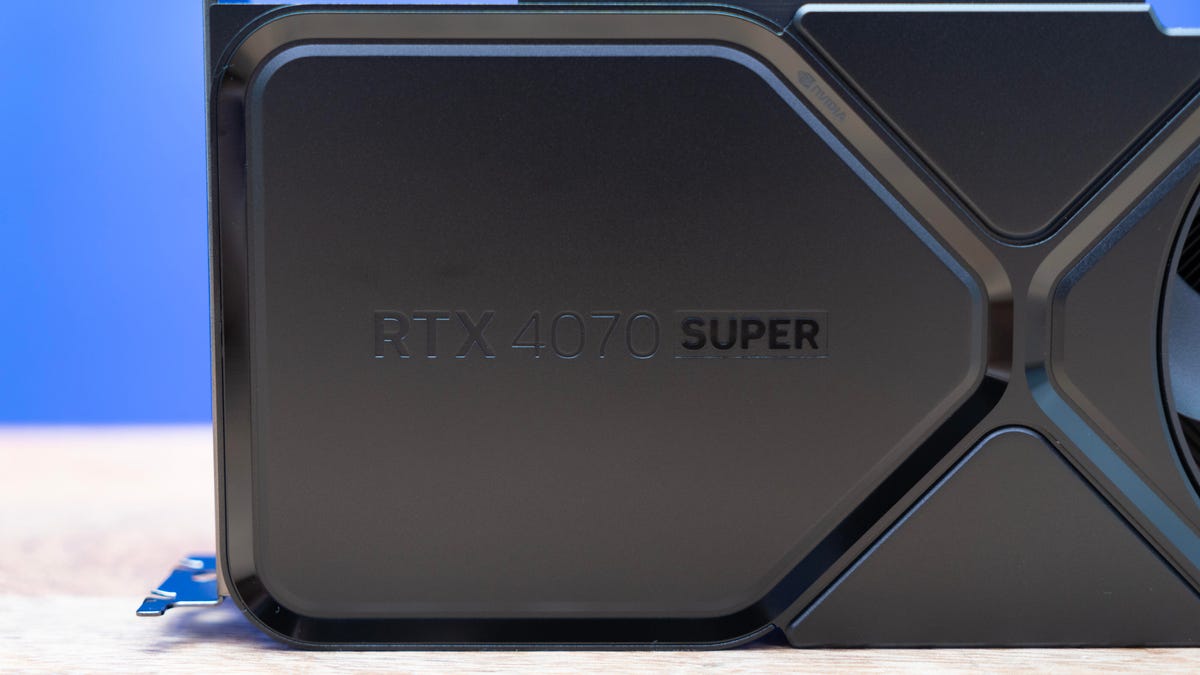Reviewing the “Super” versions of Nvidia’s GeForce gaming GPUs is pretty straightforward: They’re tuned to hit a certain level of performance above the cards they replace, which means the RTX 4070 Super provides a decent uplift over the RTX 4070: typically about 15% in DLSS and 10 to 20% in gaming and graphics. Like the RTX 4070, the RTX 4070 Super seems like a well-rounded gaming card choice. Its performance straddles highest quality 1080p through entry 4K gaming (and video editing), hitting all of 1440p in between.
Making a recommendation, though, isn’t quite so clear cut, since the RTX 4070 is staying on the market at nominally $50 less than the $600 Super. And while the Super performs better than the RTX 4070, everything we said about that card only 10 months ago still holds true — including that it’s the least expensive way to hit all the same targets.
Aside from having 20% more cores and other computational components over the older card — Tensor (AI) cores, RT cores streaming multiprocessors and so on — little has changed from one generation to the next. The Founders Edition card I tested does have a slightly different finish; it’s a bit more refractive, so it reflects the colors in my system a tad more. Given that the card doesn’t have its own illumination, it’s a perk. As before, the size and power requirements make it a good fit for midsize systems.

The RTX 4070 Ti, on the other hand, pulls ahead of the 4070 Super by a wider margin in 4K, and I expect the imminent 4070 Ti Super will further increase the gap between them, thanks to more everything. But the price gap is a lot more significant as well: At least $200 for the Ti over the Super.
And while you’ll probably still be able to get the 4070 Ti for a while after the 4070 Ti Super ships next week, the variant of the GPU it’s based on won’t remain in production. If you can snap up the older one at $650 or less, it might make sense to get that card instead. Either is much better than the 4060 Ti, unless your system — or your budget — won’t accommodate these.
Nvidia GeForce RTX 4070 Super Founders Edition
| Memory | 12GB GDDR6X |
|---|---|
| Memory bandwidth (GBps) | 504 |
| Memory clock (GHz) | 10.5 |
| GPU clock (GHz, base/boost) | 1.98/2.475 |
| Memory data rate/Interface | 21Gbps/192 bits |
| RT cores | 56 |
| CUDA cores | 7,168 |
| Texture mapping units | 224 |
| Streaming multiprocessors | 56 |
| Tensor cores | 224 |
| Process | 4nm |
| TGP/min PSU (watts) | 220/650 |
| Max thermal (degrees) | 194F/90C |
| Bus | PCIe 4.0×16 |
| Size | 2 slots |
| Launch price | $600 |
| Ship date | Jan. 17, 2024 |
Though the 4070 Ti only needs a half-slot more width than the 4070/Super, that means it will block an entire second slot on many motherboards and it might not even fit in some smaller systems.
A lot also depends on what you’re upgrading from. If it’s an RTX 20-series card or older, almost anything in the 40-series line will seem faster. The Super pulls even with and occasionally passes the RTX 3080 Ti in 1440p, but the latter still performs better in 4K.
The closest AMD competitor is the Radeon RX 7800 XT. It’s roughly $50 to $100 cheaper, and the performance is close if you want to save some money, plus it does perform better than the older RTX 4070. The caveat is, it lags quite a bit when you push the quality into ray tracing (still better than the 4060 Ti, though). The RTX 4070 Super also performs better on AMD’s own FidelityFX Super Resolution than the RX 7800 XT (the RTX 4070 does a bit better as well).
Like most of its siblings, if your system doesn’t have the RTX 4070 Super requires you use either the 8-to-12-pin adapter that comes in the box or have PCIe 5 power connectors — which you’re unlikely to have unless you’re upgrading your power supply in addition to the GPU. The 4070 Super isn’t an unusually tall card, but with the adapter you have to be careful because you don’t want to put undue pressure on it.
In the coming weeks, the new RTX 4070 Ti Super and RTX 4080 Super will start shipping, but I don’t think they’ll change the equation for the buying decision for 1440p. And while Nvidia usually rolls out a new architecture every two years, which would put the update in mid-to-late 2024, Nvidia’s roadmap indicates that the company doesn’t plan to unveil a new consumer/gaming architecture until 2025. And even then we’ll probably see the top-of-the-line GPUs before the mainstream models that would replace this. So, for once, the only reason you might have to put off spending the money is to wait until big sales hit.
Relative performance of other GPUs
Shadow of the Tomb Raider gaming test (1440p)
3DMark Time Spy graphics test
3DMark Fire Strike Ultra
Guardians of the Galaxy (1440p at maximum quality with ray tracing)
Procyon Video
SpecViewPerf 2020 SolidWorks (4K)
Cinebench 2024 (GPU)
3DMark Speed Way (DX12 Ultimate)
Test PC configuration
| Custom PC | Microsoft Windows 11 Pro (22H2); 3.2GHz Intel Core i9-12900K; 32GB DDR5-4800; 2x Corsair MP600 Pro SSD; Corsair HX1200 80 Plus Platinum PSU, MSI MPG Z690 Force Wi-Fi motherboard, Corsair 4000D Airflow midtower case |
|---|